Estimated reading time: 9 minutes
It May Be One of the Most Nutritious Soups You’ll Ever Eat and if You Own a Crockpot, It’s a Cinch.
Perpetual soup is a broth-based soup that is simmered for days, weeks, months, and even years. In fact, there are stories about broths in China and Japan that have simmered non-stop for more than a century.
Every day, more water is added to the pot along with the day’s trimmings from meats like chicken, duck, beef or pork along with vegetable scraps. In Hong Kong, people will stand in line around the block at some noodle stands that offer one of these ancient soups or stocks as an ingredient.
Want to save this post for later? Click Here to Pin It on Pinterest!
A Brief History in Soup
During pioneer times in North America, a large kettle was suspended over a fire and all of the pioneers in the encampment or village would share the never-ending kettle of soup. Stale bread often accompanied the soup and a simple dip of bread was both a satisfying and filling meal.
Cooks on cattle drives and in logging camps also kept a kettle going around the clock to satisfy the hungry cowboy or logger. This perpetual soup was often referred to as “Skilligalee.”
Today the kettle of choice is a crockpot. It’s perfect for perpetual soup because it has multiple heat settings and can easily maintain a large crock of soup for days, weeks, and even months.
Ever-Changing Flavors
One of the things that make perpetual soup special is the ever-changing flavor of the broth depending on the ingredients added on any given day. Parsnips and carrots add a natural sweetness while roasted beef bones add a savory flavor and a deep and rich amber color to the broth.
The Fish and Shellfish Caution
A lot of recipes for Skilligalee or perpetual soup call for the addition of fish bones and fish heads in addition to shellfish in the shell. This is a great idea if you’re making stock for bouillabaisse, but combining seafood with meaty bones from beef, pork, and poultry might give you a curious flavor that some people don’t like.
As a general rule, you might want to make a dedicated fish and shellfish perpetual soup and leave the beef, pork, and poultry bones out. Otherwise, the fishy flavor may last and last.
Another caution with fish and shellfish is the amount of time they are allowed to simmer in the water. The standard recommendation when making fish stock is to remove the fish bones, heads, and the shellfish after 30 minutes. Otherwise, the stock develops a cloudy white color.
The Difference Between a Stock and a Broth
In a word, it’s salt. A stock is a decoction of flavor from vegetables and meat bones or fish and shellfish. A broth occurs after salt is added to the stock.
Salt is optional in perpetual soup, especially if you or someone is on a sodium-restricted diet. You’ll also find that the richness of the soup grows and develops with time and salt may not be missed as a flavoring ingredient.
The Bone Broth Benefit
You may have heard about the benefits of bone broth. It’s very popular in paleo diets and many people have taken to making it for its health benefits. In a nutshell, bone broth has various minerals, like calcium, phosphorus, magnesium, and potassium.
It’s the calcium in particular that promotes bone health and is particularly beneficial for the elderly who sometimes suffer from bone degeneration. It also contains gelatin which is very soothing and healing to the gut, and the gelatin and dissolved cartilage can help with stiff joints and arthritic conditions.
The Apple Cider Vinegar Secret
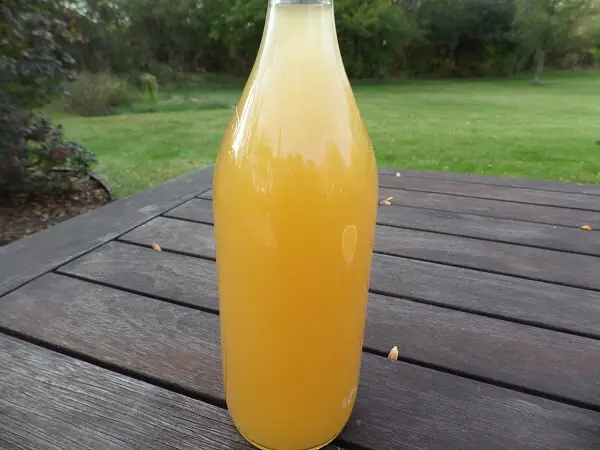
Just one tablespoon of apple cider vinegar in the pot will accelerate and facilitate the release of vital minerals from bones in the pot. You won’t taste it because it’s such a small amount relative to the amount of water, but it does a great job of enriching the broth with calcium and other minerals.
Prepping “Dem Bones”
Poultry carcasses are a cinch. The turkey, duck, or chicken has been roasted or boiled and the remaining meat on the carcass along with the bones will do nicely in a bone broth for a perpetual soup. Beef or pork bones should be roasted, especially beef bones identified in a grocery store as “soup bones.” You can easily find these in any ethnic grocery store and some regular grocery stores as well.
Roast any raw bones on a cookie sheet or baking pan at 350 degrees F for 30 to 45 minutes or until the meat on the bones has caramelized. This will lend a rich amber color to the broth and a savory flavor. Don’t forget a splash of apple cider vinegar as well.
Vegetable Do's and Don’ts
Some vegetables are perfect for perpetual soup. Others are not so good. Onions and carrots are a good example of “go-to” vegetables for a great broth and perpetual soup. Beets can be problematic because they will color everything red from the broth to the vegetables. They’re okay to add if you love them, but it’ll be a while before the red color in the soup begins to fade.
You'll want to think twice about any vegetable because all of the flavors meld together. Some vegetables are highly flavorful and can dominate the flavor profile of the soup. Here’s a list of perpetual soup-friendly vegetables and some that can give an off or highly polarizing flavor.
Good to Go
- Onions
- Carrots
- Celery
- Parsnips
- Rutabagas
- Kale
- Spinach
- Green onions
Not the Best in General
- Garlic (good for you but some people don’t like it and it lasts)
- Beets (colors everything red)
- Turnips (sometimes bitter)
- Cauliflower (dominant flavor)
- Radishes (dominant flavor that lasts)
- Broccoli (another dominant flavor)
There’s nothing wrong with vegetables like turnips or broccoli. If you like them for their taste or health and nutritional benefits, go ahead and add them. Just remember that their flavors will linger long after some of them are gone from the pot.
Other Ingredients to Avoid
Many recipes for perpetual soup call for the addition of pasta, rice, or bread. These ingredients can certainly be cooked and added after a bowl if filled with broth, but adding these ingredients to the pot can create a problem.
Pasta like macaroni noodles or any rice will maintain their integrity for a day but as time goes on, they tend to soften and dissolve. The result is a mushy, pasty texture and color. Starches in any form don’t last long in any liquid over a period of time and can ruin a great batch of perpetual soup if blindly added to the broth.
Making Perpetual Soup
INGREDIENTS:
- Pure, spring water. Avoid well water which can have an iron aftertaste or tap water which can have residual flavors from fluoride to chlorine. You can filter water if you like, but bottled spring water is best.
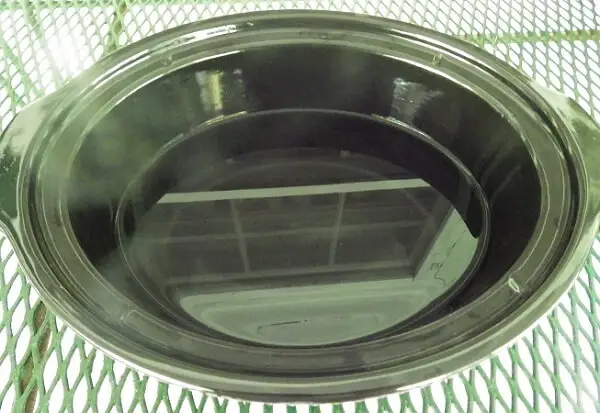
- Beef bones, soup bones, pork bones and poultry carcasses. If you want a fish broth, you can use fish bones or fish heads or shellfish like crawfish, shrimp, clams, and mussels.

- Vegetables from the “good to go” list. If you are just using them to infuse the broth, they can be large and uncut or cut coarsely. If you plan to eat the vegetables as part of the soup, cut them so they are spoon-size.
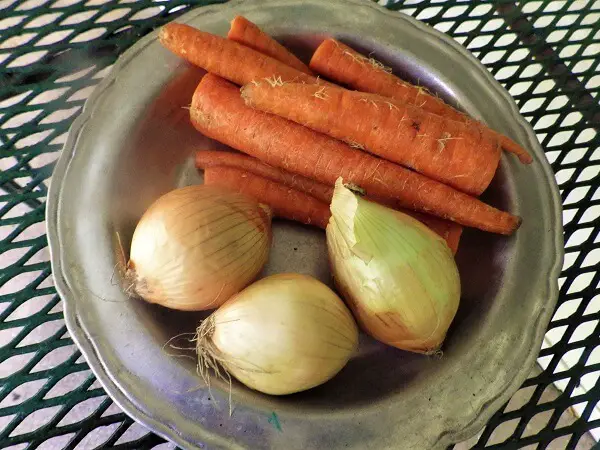
- Season to your taste. This includes salt, pepper, bay leaves, herbs like basil or thyme, and green leafy vegetables like kale or spinach. In the wild, you can add dandelion greens, plantain leaves, clover, or purslane.
DIRECTIONS:
- Add the water to a crockpot until the pot is 2/3’s full.
- Turn the heat to high and add the bones and vegetables.
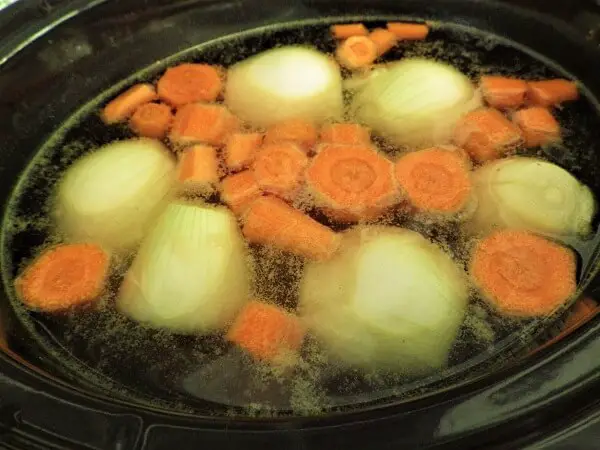
- Cover the crockpot. When the soup comes to a boil, reduce the heat to low and allow to simmer overnight. 12 to 24 hours is ideal.
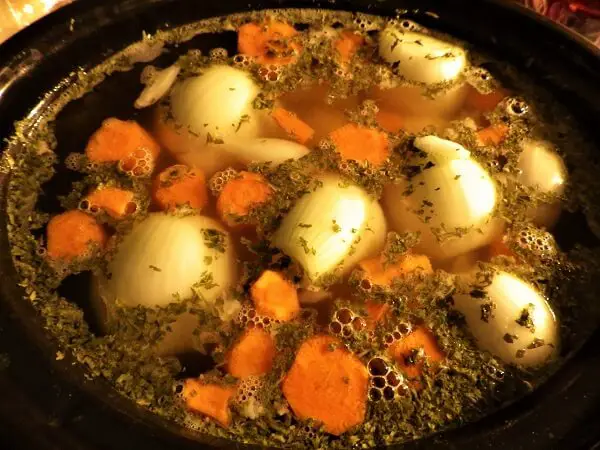
- Taste the soup in the morning and season to suit your taste. Remove the bones and discard. Reduce the soup to warm and help yourself.
- To replenish the soup, add more water, vegetables, and meat bones or meat scraps. Put the crockpot on high and bring to a boil for 15 minutes.
- Adjust the seasonings and put the crockpot on warm. Continue with this replenish cycle over the days and weeks.
To Strain or Not to Strain
If you want a pure broth, strain the soup through cheesecloth layered in a colander. If you want to eat the vegetables in the soup, remove the bones and dig in. You can also add rice that you cooked using the broth or simply make rice that way as a side dish.
Pastas can also be cooked separately and added to a bowl of soup. But whether you eat it as a soup or sip it as a bone broth, perpetual soup will forever please your palate.
Like this post? Don't Forget to Pin It On Pinterest!
You May Also Like:



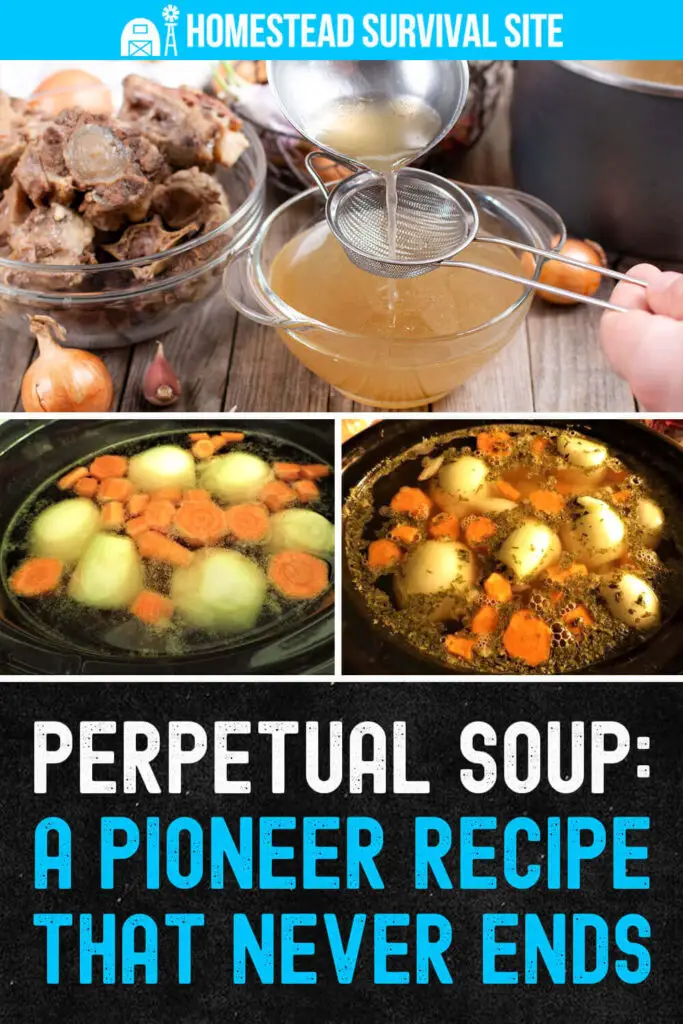









We called this ‘Depression Soup’ (historic, not emotional) at my grandmother’s house. Occasionally a chewy bit turned out to be a rubber band. Not sure how that happened.
If you used rotisserie chickens or their carcasses that you picked up at the grocery store for the soup, those are usually bound up with rubber bands.
I found this soup recipe in a MOTHER EARTH NEWS article. You can safely store it in your refrigerator in a quart canning jar. You have to boil it once a week. Plus add the vinegar. I had a jar in my refrigerator once for three months. It was wonderful.
Left over baked chicken is wonderful in it. When you open a can of approved vegetables; pour the can liquid into the jar. I have not made it lately( I am now not living alone anymore). But I highly recommend this recipe. Keeping it in acrock pot is an interesting idea.
Elbert
How long do you boil it (once a week)?
Our black powder group would make “Stone Soup” in a huge iron pot. Toss in a river rock and invite everyone to contribute something. Cleaned rabbit, squirrel, or store bought meat, local greens, canned vegetables, even fruit! On guy dumped a #10 can of pineapple! Keep in mind, the pot probably held 30 gallons. Stirred with a canoe paddle, over a slow fire after the initial boil. We had about 200 to feed…wasn’t much left.
I’m unclear though- if you keep this soup going for weeks. Does it stay in the crock pot cooking? Or you eventually put it in the fridge then cook for 12-24 whenever you add.
I save the vegetable water and any broth to put into soup mostly through the Spring and Summer. Then I take enough to add to the mix I make and we have soup. Although there is only 5 of us we never have enough for leftovers. When there are some my husband takes and eats it for breakfast the next day. I also add leftover veggies from meals. Soup is a staple in our house.
Interesting article. Not to be nit picky, but this perpetuated notion that salt adds flavor and is used as a seasoning is a long held myth.
Salt makes our tongues (Taste buds) more sensitive the flavors, thus it enhances or magnifies our ability to taste foods. And it is also somewhat addictive. Like many chefs or diners who can’t even begin to cook or eat without salting their food, there is the tendency to keep adding more and more salt. And trust me, it does cause people health issues.
I rarely use more than a sprinkle of sea salt on friend eggs, rice or anything else. A pinch is enough. Too much and it tastes horribly salty once you purge yourself of excessive sodium consumption. And if you mix garlic and onion powder together they are an excellent salt substitute. Kind of a universal mix to step up bland tasting foods. Seasonings make things taste better and they’re healthy for us.
When I ran a K-12 school working dads often dropped in to visit the kids during lunch time. I started saving nearly every leftover and liquids off of canned veggies in a gallon jar. Left over spaghetti, meats, beans all went in. Soon several teachers did the same. 2 morning per week I made soup for anyone who wanted to drop in. It ended up being very popular. Several self employed couples added Fry bread or homemade breads. Others provided bowls and spoons. 20 to 40 adults showed up for lunch and conversation. Any kid without a lunch got a bowel of soup.. it was easy and fast to add bullion powder, rice or pasta to make it go further in a hurry. I kept mixed vegetables, small pastas, instant rice and bullion powder in a cupboard for those days we needed more.
We just called it “soup and conversation” and invited any parent who wanted to come.
You are a beautiful soul…can I be your neighbour? Let me know where you are I shall come over in a heart beat…beautiful story of hiw to be a genuine human being